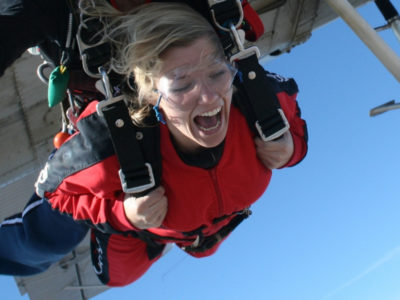Parachuting vs skydiving – both refer to jumping out of an airplane. So what’s the difference? Well, it’s all in the details. While every skydive utilizes a parachute, parachuting does not always involve a skydive!
So what’s the difference between skydiving and paratrooping (or parachuting)? Let’s break it down.
What is Parachuting?
Parachuting refers to a drop or cause to drop from an aircraft by parachute. It’s pretty simple – if you leave an aircraft and use a parachute, you’re parachuting. By that definition, all disciplines of skydiving are considered parachuting. But, technically speaking, parachuting refers to a specific procedure that sets it apart from other skydives. And for that, we have to go back to the beginning of our beloved sport.
 Parachuting technology was primarily developed and utilized by the military before people started jumping out of airplanes for fun. Typically, the parachutes utilized in military operations (then and now) were extracted by a static line system where the parachute is automatically deployed and there is no freefall. A static line is a cord attached to the aircraft at one end and to the parachute at the other. As the jumper exits the aircraft, the static line pulls the parachute out of the container on the jumper’s back.
Parachuting technology was primarily developed and utilized by the military before people started jumping out of airplanes for fun. Typically, the parachutes utilized in military operations (then and now) were extracted by a static line system where the parachute is automatically deployed and there is no freefall. A static line is a cord attached to the aircraft at one end and to the parachute at the other. As the jumper exits the aircraft, the static line pulls the parachute out of the container on the jumper’s back.
While both the military and civilians still utilize static lines for parachuting, the sports side of things has evolved in exciting ways. Thanks to ever-evolving equipment, sport parachutists can participate in several canopy specialties, such as:
- Canopy Relative Work (CRW) – Groups of canopy pilots create formations under individual parachutes
- Swooping – Canopy pilots fly small parachutes and induce high speeds to cover long distances over the ground or water
- Accuracy – Canopy pilots hover and land on a target that has only a two-centimeter diameter
With the help of this background information, we can be more comprehensive with our definition: Parachuting is any jump from an airplane where the parachute ride is the main focus of the jump.
What is Skydiving?
Now that we know what classifies a jump as parachuting, let’s talk about the markers that signify a skydive. From both a technical and an entertainment perspective, the crown jewel of a skydive is the time spent in freefall. It helps to think of modern-day skydiving as different from parachuting because the focus is on body flight rather than the parachute ride.
 Just like sport parachuting, skydiving came about as something fun that evolved out of military operations. Pretty quickly, those early jumpers discovered that people could fly their bodies in multiple ways if parachute deployment was delayed a bit after exiting the airplane. This opened up a whole new world, and several skydiving disciplines have emerged over the subsequent decades.
Just like sport parachuting, skydiving came about as something fun that evolved out of military operations. Pretty quickly, those early jumpers discovered that people could fly their bodies in multiple ways if parachute deployment was delayed a bit after exiting the airplane. This opened up a whole new world, and several skydiving disciplines have emerged over the subsequent decades.
Individuals can fly their bodies in different orientations to create shapes and formations in what is known as Formation Skydiving (FS). Some jumpers prefer to fall with their bellies facing the earth, while others might fly sitting up or even on their head! There are even jumpers who cover pretty impressive horizontal distances with the use of wingsuits or by flying their bodies at an angle to manipulate the wind of freefall.
Another aspect of skydiving that has developed in more recent years is tandem skydiving. You probably know the difference between skydiving and tandem skydiving, but let’s lay it out there too. Tandem skydiving is still skydiving! The only difference is that, in tandem skydiving, a student is attached to the front of an instructor so that inexperienced jumpers can learn the ropes before going solo. It’s also a great way for adventure enthusiasts to see what it’s like to skydive without having to commit to getting a skydiving license!
Skydiving and parachuting are inextricably connected, and the improvements in parachuting technology are what paved the way for skydiving as we know it today. Whether you have a love of parachute flight or the freefall of skydiving, there is something for everyone to enjoy in the sky we call home!
Key Differences Between Parachuting and Skydiving
As we’ve established, an easy way to differentiate between parachuting and skydiving is to think of parachuting as a focus on the flight of the parachute (also known as the canopy) and skydiving as a focus on the flight of the body. But that’s the simplified version of a much more complicated topic.
The sensations and requirements of skydiving versus parachuting are very different and result in some major variations in each experience. Here are some key differences and common questions regarding parachuting and skydiving.
- Purpose – Someone may choose to parachute or skydive for very different reasons. Parachuting, in the case of the military, can be very utilitarian, while skydiving is almost always for fun. Even in sport parachuting, the focus is much more on maximizing the use of the parachute and becoming one with the equipment.
- Requirements – Beginner-level skydiving happens to be much more involved than basic parachuting jumps, so the process of jumping solo looks quite a bit different for each. To skydive solo, a student must learn all of the parachute skills PLUS the ins and outs of flying their body in freefall. Someone who goes straight to parachuting can jump solo as soon as they master the parachute training.
- Sensation – Yes, both skydiving and parachuting involve leaping out an airplane door. But skydiving is a whirlwind of emotions that range from fear to euphoria, and the speed of freefall sits in stark contrast to the gentle gliding of parachute flight.
- Is it harder to breathe skydiving? Some people do report difficulty breathing in the extreme winds of freefall, something that isn’t an issue on parachuting jumps. Luckily, screaming helps kick-start breathing, even in freefall!
- Is it harder to breathe skydiving? Some people do report difficulty breathing in the extreme winds of freefall, something that isn’t an issue on parachuting jumps. Luckily, screaming helps kick-start breathing, even in freefall!
- Altitude – The altitude paratroopers jump from is generally much lower than that of skydivers. Skydivers tend to jump from 10,000 feet to 15,000 feet, while parachuters can jump from as low as 3,000 feet. That’s because of the extra altitude required to accommodate for freefall on a skydive.
Which Adventure is Right for You?
The decision to partake in either parachuting or skydiving is ultimately a personal one. Think about what you’re looking for out of the adventure. Both supply an ample dose of adrenaline, stimulation, and incredible views. But are you seeking high energy, heart-pumping excitement (skydiving), or something more serene and beautiful (parachuting)? Who knows, you might even enjoy both! There’s only one way to find out – book your jump today! Blue skies!
Copyright © 2025, Skydive Monroe, All Rights Reserved.
DropZone Web Design & Marketing by Beyond Marketing, LLC



